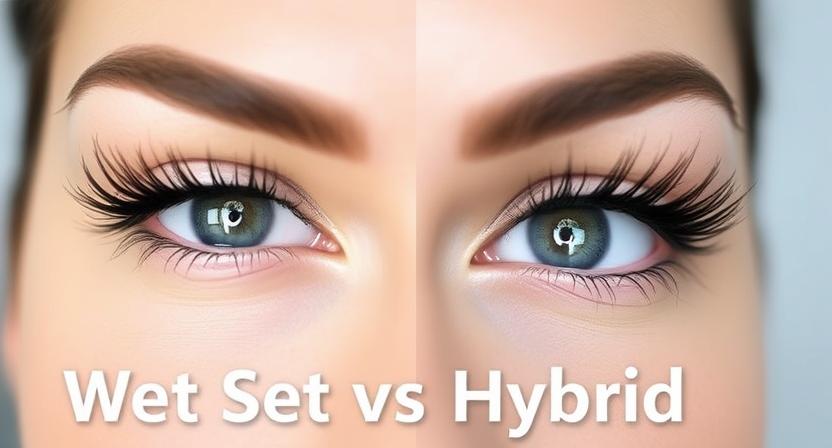Wet Set vs Hybrid: Which One Suits Your Style Best?
Understanding the subtle differences between various configurations is becoming crucial as hybrid technology continues to advance across industries. Wet set vs. hybrid is one of the increasingly common comparisons in the technical and beauty fields. Despite coming from two distinct fields—engineering and cosmetics—these names now illustrate how hybrid systems are evolving and being used in a variety of fields. This blog examines the differences between these ideas, their relationship to hybrid innovation, and the information professionals and consumers should be aware of when making a decision.
Defining Wet Set and Hybrid in the Context of Modern Innovation
When describing styles, methods, or systems, the terms “wet set” and “hybrid” are both employed. They describe lash procedures in the beauty industry. They refer to technological systems that combine several functions. Performance, effectiveness, and application are all influenced by the differentiation.
While hybrid settings integrate elements of two or more systems to get a balanced result, wet sets usually concentrate on uniformity and finish. Knowing their functions helps one understand how hybrid arrangements are used in many industries.

Wet Set vs Hybrid in Beauty: A Brief Overview
One of the first sectors to make this analogy widely accepted was the beauty industry. The goal of wet sets in lashes is a glossy, recently applied appearance. They produce a consistent look and complement strong styling. In contrast, hybrids combine traditional lash extensions with volume for a more textured look.
The use of hybrid configurations for performance and personalisation in various industries is seen in this comparison. The objective is to strike a balance between aesthetics and efficiency, a concept that is becoming more popular than beauty.
Wet Set vs Hybrid in Automotive Hybrid Technology
The distinction between pure electric vehicles (wet set equivalent) and hybrid versions exemplifies the concept of wet set vs. hybrid in automotive engineering. Hybrid vehicles mix electric and combustion engines for increased range and performance flexibility, while entirely electric systems provide a sleek, single energy source.
Because of this balance, hybrids are favoured by consumers who wish to cut emissions without compromising range. Compared to single-mode energy installations, the hybrid vehicle adapts to both urban and highway conditions more successfully.
Choosing Between Wet Set and Hybrid in Power Generation Systems
The choice between targeted and mixed solutions is also demonstrated by power generating. In this context, a “wet set” would be a system that uses only one energy source, such as solar or hydro. However, hybrid systems—like solar-wind or hydro-solar hybrids—combine two or more energy sources.
Even in the event that one source is unavailable owing to bad weather or usage restrictions, this dual configuration guarantees uninterrupted power. Hybrids provide unparalleled dependability in areas with unpredictable weather.
Wet Set vs Hybrid in Consumer Electronics
Systems in electronics and smart gadgets are becoming more and more capable of hybrid operation. Consider smartphones that serve as hubs for both work and play. Calculators and MP3 players are examples of single-purpose devices that would be the “wet set” counterpart.
Hybrid systems offer cost-effectiveness and flexibility as user demands increase. Performance is increased and fewer devices are needed when hardware and software improvements are combined into a single unit.

Energy Storage Solutions: Hybrid vs Single-Mode Systems
Battery storage and backup power solutions are also discussed in relation to wet set versus hybrid. Conventional lithium-ion cells may be used in single-mode systems. Conversely, hybrids incorporate renewable charging sources, alternate chemistries, or capacitors.
Efficiency, discharge rate, and recharge cycles are all increased by hybrid energy storage. Hybrid battery systems can eventually result in increased reliability and less maintenance for businesses needing long-term solutions.
Sustainability and Cost Efficiency: A Comparative Outlook
When it comes to sustainability, hybrid systems are frequently in the forefront. They lessen reliance on a single mechanical process or energy source by integrating several inputs. This frequently leads to more effective energy use and less waste.
In terms of cost, a hybrid system could initially seem more costly. However, it adds value over time through improved productivity, a longer lifespan, and cheaper operating expenses. Although a single-mode “wet set” system might be less expensive initially, it is less flexible.
Wet Set vs Hybrid: Key Performance Indicators in Innovation
Performance is a key factor when comparing wet set and hybrid unique design. Wet setups are typically less adaptable but more predictable. Hybrid systems remain stable in the face of changing demands and adjust to various situations.
Because of their adaptability, hybrids are perfect for sectors like consumer goods, energy, and transportation where change occurs often. Because of its scalability and evolution, hybrid models are frequently preferred by engineers and product developers.
Market Trends Favoring Hybrid Systems
Consumer trends indicate that hybrid technology is becoming more and more popular. According to surveys, people appreciate systems that blend strength, adaptability, and beauty. Hybrid systems are rapidly displacing antiquated single-source solutions in industries like energy and transportation.
This change is supported by the growth of electric cars, smart houses, and modular technology. From solar-battery home kits to AI-powered assistants, hybrid setups provide the functionality and ease of use that consumers have come to expect.

Final Thoughts on Wet Set vs Hybrid Across Industries
The decision between hybrid and wet set configurations is based on certain objectives. Each offers advantages, whether in energy systems, technology, automobiles, or beauty. A wet set provides simplicity and consistency. A hybrid provides performance that is ready for the future and flexibility.
Knowing these differences will be increasingly important as hybrid technology develops. Selecting solutions that meet their operational, aesthetic, and financial requirements will be advantageous for both professionals and customers.
Need more Information? Also read these topics for more information
2025 Honda CR-V Hybrid Maintenance Schedule Guide
beparfum.com.tr hybrid work model for modern businesses
What to Consider Before Choosing a System
Evaluate the intended purpose of your system or product. Ask these:
- Does long-term adaptability matter
- Will performance be impacted by environmental factors?
- Is consistency in appearance more important than flexibility?
- Will the system likely change in the future?
Making informed choices today means better performance tomorrow.




Post Comment